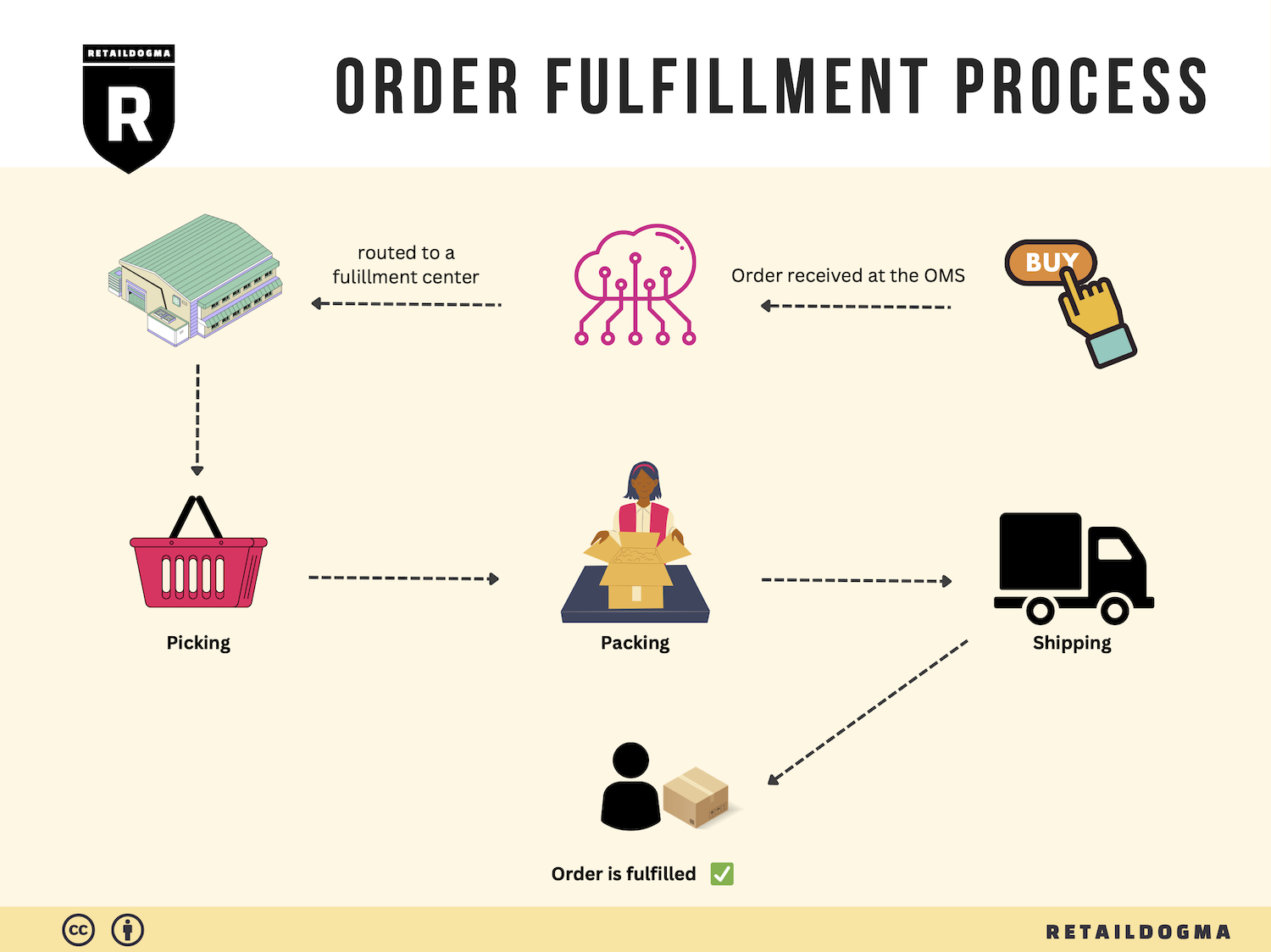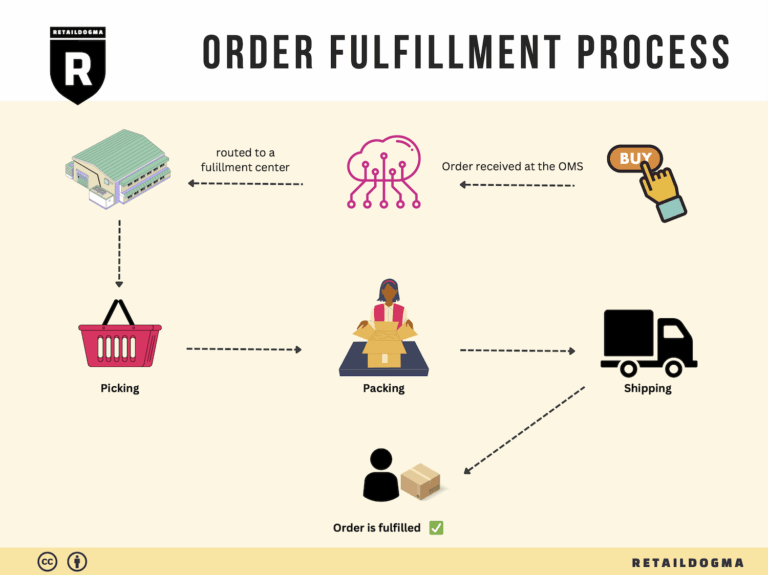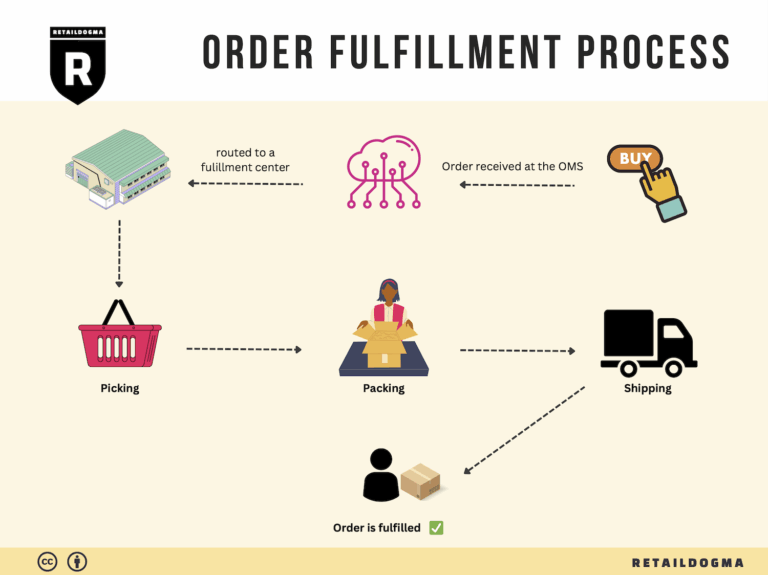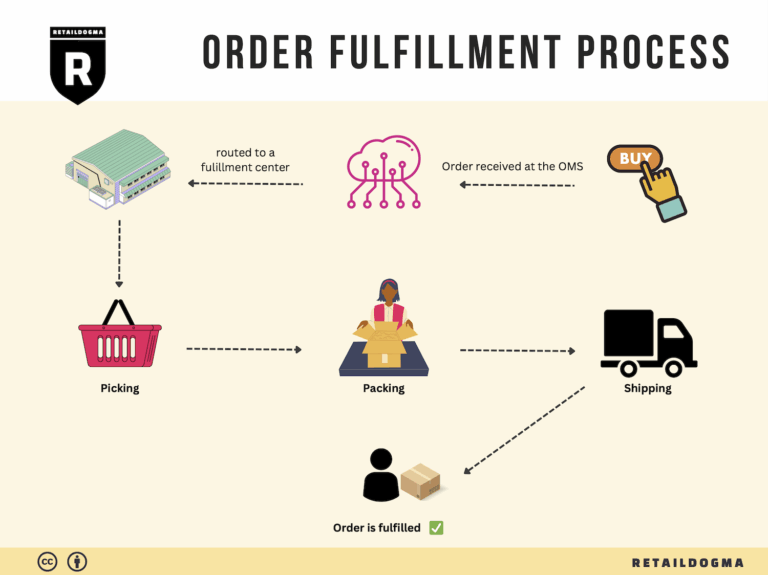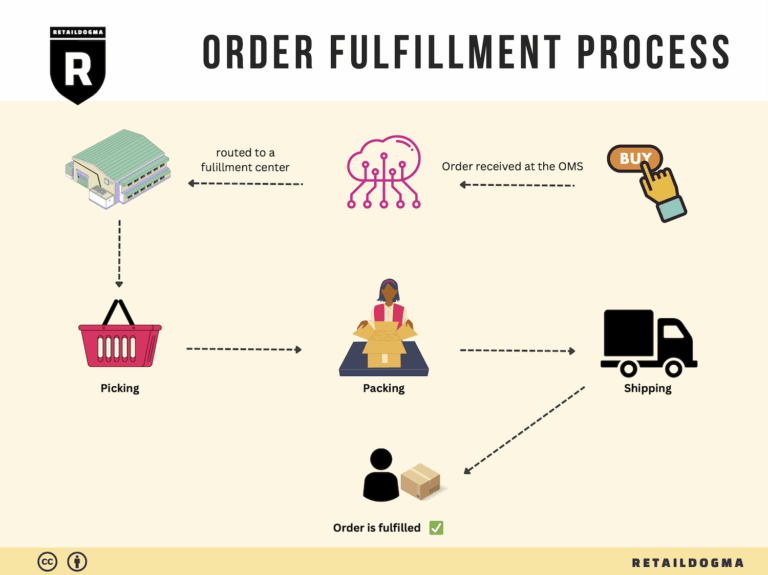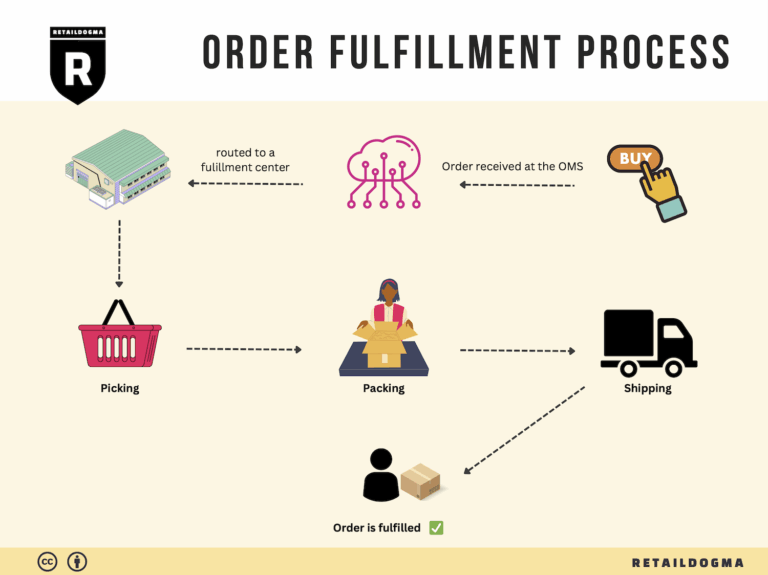How Order Fulfillment Works: A Step-by-Step Guide for Businesses
What is E-commerce Fulfillment? An Introduction for Growing Businesses
Understanding E-commerce Fulfillment: A Key to Your Success
As an e-commerce business owner, you may find yourself grappling with the complexities of packing and shipping orders, especially as your sales begin to scale. The excitement of growing your business can quickly turn into an overwhelming task if you lack a streamlined fulfillment process. Fulfillment, at its core, is simply the journey of getting a product from your inventory to your customer’s doorstep.
In today’s competitive landscape, mastering this process is crucial for maintaining customer satisfaction and operational efficiency. This guide aims to demystify e-commerce fulfillment, offering you insights that will help you make informed decisions about your logistics strategy.
What This Guide Covers
-
Fulfillment Models: We will explore various fulfillment models, including third-party logistics (3PL) and Fulfillment by Amazon (FBA). Understanding these options will help you determine which model aligns best with your business needs and growth trajectory.
-
Core Services: Fulfillment is more than just shipping. We will delve into the essential services involved, such as inventory management, order processing, packing, and shipping. Knowing what services are available will enable you to choose a partner that can meet all your logistical needs.
-
Choosing a Fulfillment Partner: Selecting the right fulfillment partner is one of the most critical decisions you’ll make. We’ll provide practical criteria to consider, including location, technology capabilities, and customer service. A good partner can enhance your operational efficiency and improve customer satisfaction.
-
Understanding Pricing: Fulfillment costs can vary widely based on the services you choose and the volume of orders you process. We will break down the typical pricing structures you might encounter, helping you to budget effectively and avoid any hidden fees.
Empowering Smart Decisions
The goal of this guide is to empower you, the business owner, with the knowledge and tools necessary to navigate the complex world of e-commerce fulfillment. By understanding your options and knowing what to look for in a fulfillment partner, you can make smart, strategic decisions that will drive your business forward. With the right fulfillment strategy in place, you can focus more on growing your brand and less on the logistics of getting your products to customers.
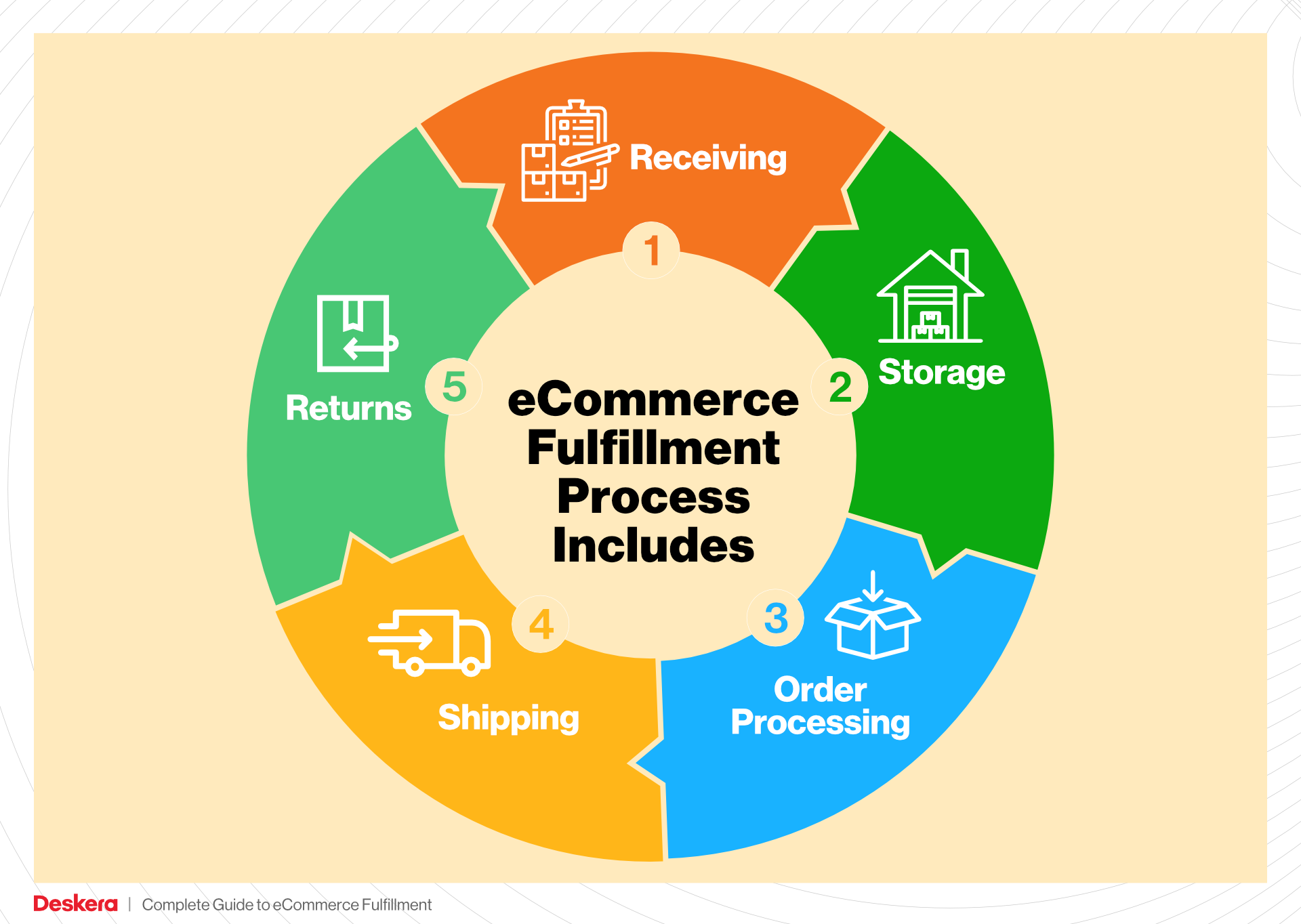
What You’ll Learn In This Guide
- What is E-commerce Fulfillment? An Introduction for Growing Businesses
- The Order Fulfillment Process: From ‘Buy’ Button to Customer’s Door
- Comparing Fulfillment Models: In-House vs. 3PL vs. Dropshipping
- A Deep Dive into Amazon FBA: Pros, Cons, and Who It’s For
- Core Services Offered by Fulfillment Centers
- How to Choose a Fulfillment Partner: A 6-Point Checklist
- Understanding Fulfillment Pricing: A Breakdown of Common Fees
- Frequently Asked Questions (FAQs) about Fulfillment
- Conclusion: Is Outsourcing Fulfillment the Right Move for Your Business?
- Important Disclaimer
The Order Fulfillment Process: From ‘Buy’ Button to Customer’s Door
1. Receiving Inventory
The order fulfillment process begins with receiving inventory. This step involves the acceptance of products from suppliers or manufacturers into the fulfillment center. Each item is checked against the purchase orders to ensure accuracy in quantity and quality.
Importance: This step is critical as it sets the foundation for the entire fulfillment process. Accurate receiving helps prevent stock discrepancies that can lead to issues later in the order cycle, such as stockouts or delays.
Key Term: SKU (Stock Keeping Unit). Each product is assigned a unique SKU, which simplifies tracking and inventory management. Efficient SKU management ensures that items can be quickly located and accessed in the warehouse.
2. Warehouse Storage
Once the inventory is received and verified, the next step is warehouse storage. Products are organized and stored in designated locations within the fulfillment center. The layout may include shelves, bins, and pallets, depending on the type of products being stored.
Importance: Effective warehouse storage maximizes space utilization and enhances accessibility. A well-organized storage system reduces the time needed to find products, which is essential for fulfilling orders promptly.
Key Term: ABC Analysis. This inventory categorization technique ranks items based on their importance and turnover rates. High-demand items (A category) are placed closer to the picking area, while slower-moving items (C category) may be stored further away, optimizing the picking process.
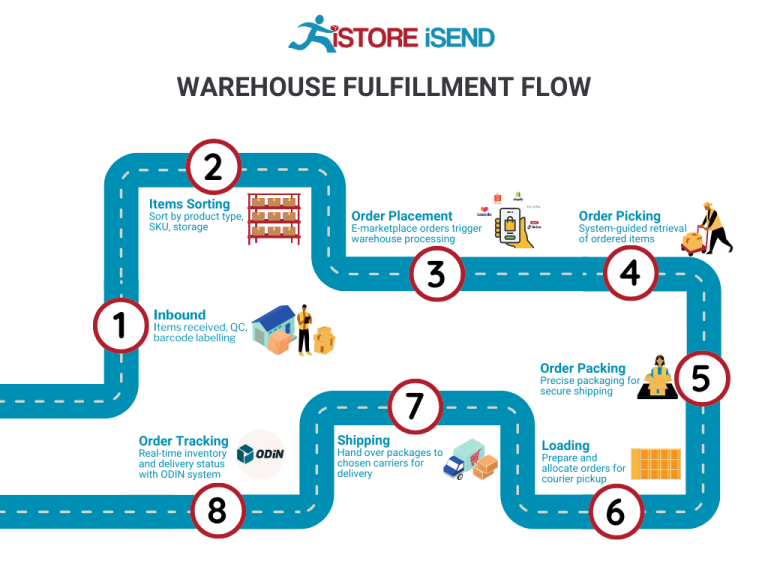
3. Order Picking
The third step is order picking, where fulfillment center staff or automated systems retrieve items from storage based on customer orders. This process can be manual or automated, utilizing pick lists or picking robots to streamline operations.
Importance: Order picking is a pivotal stage in the fulfillment process, as it directly affects order accuracy and speed. Errors during picking can lead to incorrect shipments, resulting in customer dissatisfaction and increased return rates.
Key Term: Pick Lists. These are documents or digital records that outline the items and quantities needed for each order. Efficient use of pick lists ensures that staff can quickly gather the correct items, minimizing time spent on each order.
4. Order Packing
After items are picked, they move to the order packing stage. Here, products are carefully packed into boxes or envelopes, ensuring they are secure for transit. Packing materials, such as bubble wrap or packing peanuts, may be used to protect fragile items.
Importance: Proper packing is essential for preventing damage during shipping. It also plays a role in branding; a well-packed order can enhance the customer’s experience and perception of the brand.
Key Term: Packing Slip. This document is included with the order and details the items within the package, serving both as a receipt for the customer and a reference for returns. Ensuring accurate packing slips can help streamline the return process if needed.
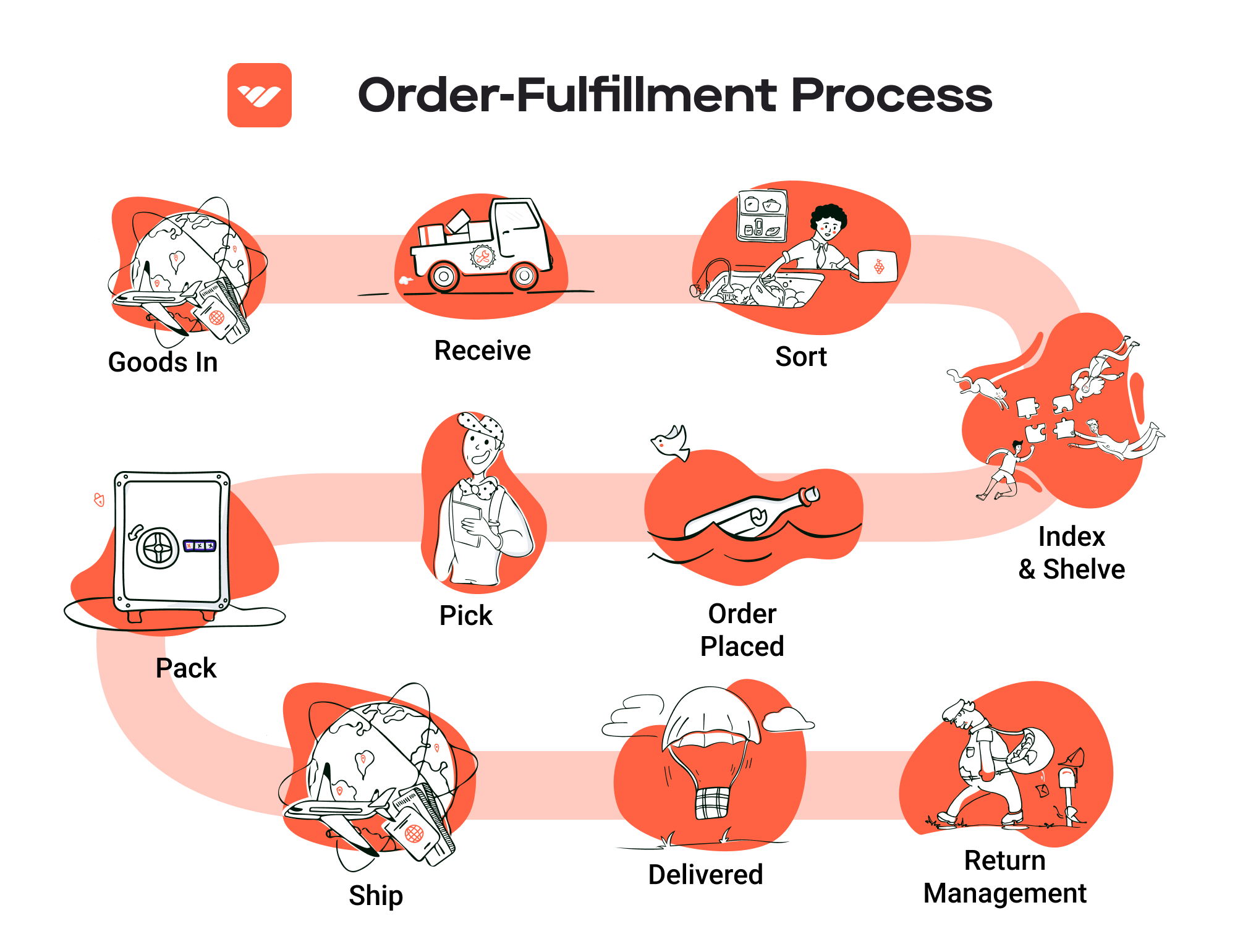
5. Shipping & Delivery
The final step in the order fulfillment process is shipping and delivery. Once packed, orders are labeled and handed over to shipping carriers for delivery to the customer. This stage includes choosing the appropriate shipping method based on speed, cost, and customer preference.
Importance: Timely and reliable delivery is crucial for customer satisfaction and repeat business. Delays or issues during shipping can lead to negative reviews and lost sales opportunities.
Key Term: Last Mile Delivery. This term refers to the final step of the shipping process, where the package is delivered from a transportation hub to the final destination, typically the customer’s doorstep. Optimizing last mile delivery is essential for enhancing customer satisfaction and reducing shipping costs.
By understanding and optimizing each of these five steps in the order fulfillment process, e-commerce businesses can improve their operational efficiency, enhance customer satisfaction, and scale their logistics effectively. Each stage is interconnected, and attention to detail at every point ensures a seamless experience from the moment a customer clicks the ‘Buy’ button to when their order arrives at their door.
Comparing Fulfillment Models: In-House vs. 3PL vs. Dropshipping
Fulfillment Model Comparison
| Model | Who Handles Inventory | Best For (Business Stage) | Key Advantage | Key Disadvantage |
|---|---|---|---|---|
| In-House Fulfillment | The business itself | Established businesses | Full control over inventory and shipping | High overhead costs and complexity in logistics |
| Third-Party Logistics (3PL) | External logistics provider | Growing businesses | Scalable and flexible solutions | Less control over inventory and potential delays |
| Dropshipping | Suppliers | Startups and small businesses | Low startup costs and minimal risk | Lower profit margins and reliance on supplier quality |
In-House Fulfillment
In-house fulfillment involves managing all aspects of storage, inventory management, and shipping within your own facilities. This model is best suited for established businesses that have the resources and demand to justify the investment in warehousing and logistics infrastructure. One of the primary advantages of in-house fulfillment is the complete control it offers over inventory and shipping processes. Businesses can implement their own quality control measures, optimize picking and packing procedures, and ensure that customer expectations are met consistently. However, this model also has significant disadvantages, including high overhead costs related to warehouse space, labor, and equipment, as well as the complexity of managing logistics. As businesses grow, they may find that the operational burden of in-house fulfillment hinders their ability to focus on core competencies, leading to a reevaluation of their logistics strategy.
Third-Party Logistics (3PL)
Third-party logistics (3PL) refers to outsourcing logistics operations to an external provider that specializes in warehousing and fulfillment services. This model is particularly beneficial for growing businesses that need to scale operations quickly without the hefty investment in infrastructure. 3PL providers offer a range of services, including inventory management, order processing, and shipping, allowing businesses to focus on their core activities such as marketing and product development. The flexibility and scalability of 3PL solutions enable businesses to adapt to fluctuations in demand without the burden of excess inventory or underutilized warehouse space. However, the trade-off is often a loss of control over inventory management and potential delays in shipping, which can impact customer satisfaction. Businesses must carefully select a reliable 3PL partner to mitigate these risks and ensure a seamless customer experience.
Dropshipping
Dropshipping is a fulfillment model where the retailer does not hold any inventory but instead transfers customer orders directly to a supplier, who then ships the products directly to the customer. This model is particularly attractive for startups and small businesses looking to minimize upfront investment and operational complexity. The key advantage of dropshipping is its low barrier to entry, allowing entrepreneurs to test products and markets without the risks associated with inventory management. Additionally, dropshipping eliminates the need for warehousing and fulfillment logistics, enabling business owners to focus on marketing and customer engagement. However, dropshipping comes with its own set of challenges. Profit margins can be lower compared to other fulfillment models since retailers often pay wholesale prices to suppliers, and the reliance on suppliers for quality and shipping can lead to inconsistent customer experiences. Businesses must conduct thorough research to select reputable suppliers and ensure they can meet quality and delivery expectations.
Conclusion
Choosing the right fulfillment model is critical for e-commerce businesses seeking to scale efficiently. Each model—In-House Fulfillment, 3PL, and Dropshipping—offers unique benefits and drawbacks that can significantly impact operational efficiency, customer satisfaction, and overall profitability. Business owners should assess their current stage, resources, and long-term goals to determine the most suitable fulfillment strategy. By aligning the chosen fulfillment model with business objectives, e-commerce businesses can create a robust logistics framework that supports growth and enhances customer experience.
A Deep Dive into Amazon FBA: Pros, Cons, and Who It’s For
Understanding Fulfillment by Amazon (FBA)
Fulfillment by Amazon (FBA) is a service offered by Amazon that allows e-commerce sellers to store their products in Amazon’s fulfillment centers. Amazon takes care of storage, packaging, and shipping to customers, as well as customer service and returns. This service is designed to simplify logistics for sellers, enabling them to focus on growing their business while leveraging Amazon’s extensive infrastructure.
How FBA Works
-
Inventory Management: Sellers send their products to Amazon’s fulfillment centers. Once received, Amazon takes responsibility for the storage, inventory management, and order fulfillment.
-
Order Processing: When a customer places an order for a product fulfilled by Amazon, the order is processed through Amazon’s systems. This includes picking, packing, and shipping the product directly to the customer.
-
Customer Service: Amazon handles all customer inquiries and issues related to orders, including returns and refunds, freeing sellers from these responsibilities.
-
Prime Eligibility: Products fulfilled by Amazon are eligible for Amazon Prime, which can significantly increase visibility and sales, given the Prime member base’s loyalty.
-
Multi-Channel Fulfillment: Sellers can use FBA to fulfill orders from other sales channels, not just Amazon. This allows businesses to manage their logistics more efficiently across multiple platforms.
Pros of Fulfillment by Amazon
-
Prime Eligibility: FBA products are automatically eligible for Amazon Prime, attracting millions of loyal Prime customers who prioritize fast and free shipping. This can lead to increased sales and visibility.
-
Customer Trust: Amazon is a trusted name in e-commerce. Using FBA can lend credibility to your products, as customers may be more inclined to purchase items that are fulfilled by Amazon due to their established reputation for quality service.
-
Scalability: FBA allows businesses to scale without needing to invest heavily in their own warehousing and logistics. As sales grow, sellers can easily send more inventory to Amazon’s fulfillment centers without needing to manage the complexities of warehousing themselves.
-
Time-Saving: By outsourcing fulfillment, sellers can focus on other aspects of their business, such as marketing, product development, and customer engagement, rather than worrying about logistics.
-
Multi-Channel Fulfillment: FBA can fulfill orders from various platforms, allowing sellers to centralize their inventory management and streamline operations across different sales channels.
Cons of Fulfillment by Amazon
-
High Fees: FBA fees can be substantial, including storage fees based on the volume of inventory stored and fulfillment fees for each item sold. These costs can add up quickly and impact profit margins, especially for lower-priced items.
-
Strict Inventory Rules: Amazon has stringent policies regarding inventory management, including limits on how much inventory can be stored and strict guidelines on product condition and packaging. Sellers must carefully adhere to these rules to avoid penalties or removal of their listings.
-
Commingling Risks: FBA may commingle inventory, meaning that your products could be mixed with similar items from other sellers. This can lead to issues with product quality and authenticity, as customers may receive items that are not as described.
-
Loss of Control: By using FBA, sellers relinquish some control over the fulfillment process. This can lead to challenges in managing brand reputation if issues arise with shipping or customer service.
-
Complex Returns Process: While Amazon handles returns, sellers may find it challenging to manage returned inventory, especially if they want to inspect or repackage items for resale.
Who is FBA Best For?
Fulfillment by Amazon is particularly well-suited for:
-
Small to Medium-Sized Sellers: Businesses looking to scale quickly without the burden of managing their own logistics can benefit from the efficiency and infrastructure that FBA provides.
-
E-commerce Entrepreneurs: New sellers who want to tap into Amazon’s vast customer base and take advantage of Prime eligibility without investing heavily in warehousing and shipping.
-
Brands with High Turnover Products: Sellers of fast-moving consumer goods or seasonal products can benefit from FBA’s ability to handle large volumes of orders efficiently.
-
Multi-Channel Sellers: Brands selling on multiple platforms (e.g., eBay, their own websites) can streamline operations by using FBA for fulfillment across these channels.
-
Businesses Focused on Customer Experience: Brands that prioritize customer service and want to leverage Amazon’s customer support capabilities will find FBA advantageous.
Conclusion
Fulfillment by Amazon can be a powerful tool for e-commerce businesses looking to scale operations and improve customer satisfaction. While it comes with challenges, the benefits of Prime eligibility, customer trust, and streamlined logistics make it an attractive option for many sellers. Understanding both the advantages and drawbacks of FBA can help business owners make informed decisions about their fulfillment strategy, ultimately positioning them for growth in the competitive e-commerce landscape.
Core Services Offered by Fulfillment Centers
Inventory Management & Warehousing
Effective inventory management and warehousing are fundamental components of any successful e-commerce operation. Fulfillment centers like Chewy’s implement sophisticated inventory management systems that allow businesses to track their stock in real-time. This involves categorizing products, monitoring stock levels, and predicting inventory needs based on sales trends and seasonal fluctuations.
The benefit of such systems is multi-faceted. Firstly, they minimize the risk of stockouts and overstock situations, ensuring that e-commerce businesses can meet customer demand without tying up capital in excess inventory. Secondly, efficient warehousing reduces storage costs and optimizes space usage, allowing businesses to scale their operations without incurring significant additional overhead. Lastly, real-time inventory visibility enhances decision-making and operational efficiency, enabling businesses to respond promptly to market changes.
Pick and Pack Services
Pick and pack services are essential for fulfilling customer orders accurately and efficiently. This process involves selecting items from the warehouse (picking) and then packaging them for shipment (packing). Fulfillment centers utilize advanced technology and automated systems to streamline this process, which can significantly enhance accuracy and speed.
The primary benefit of pick and pack services is the reduction in order fulfillment time. Fast and accurate order processing can lead to improved customer satisfaction, as customers are more likely to receive their products promptly and in good condition. Additionally, outsourcing pick and pack operations allows e-commerce businesses to focus on their core competencies, such as marketing and product development, while leaving logistics to experts. This not only improves operational efficiency but also contributes to overall business growth.
Kitting and Assembly
Kitting and assembly services involve grouping various products into a single package or creating a new product from individual components. This service is particularly beneficial for businesses that offer bundles or kits, such as pet supply companies that sell starter packs for new pet owners. Fulfillment centers can efficiently assemble these kits, ensuring that all components are included and packaged correctly.
The advantage of kitting and assembly services lies in their ability to enhance product offerings and customer appeal. By providing bundled products, businesses can encourage higher average order values and improve customer satisfaction through convenience. Moreover, fulfillment centers can manage the complexities of assembly, allowing e-commerce businesses to streamline their operations and reduce the time and resources required for these tasks. This leads to more efficient supply chain management and ultimately better profitability.
Returns Management (Reverse Logistics)
Returns management, or reverse logistics, is an often-overlooked yet crucial service provided by fulfillment centers. This process involves handling product returns, exchanges, and refunds efficiently. Effective returns management systems help businesses process returns quickly, assess product condition, restock items, and manage customer communications.
The benefits of a robust returns management system are significant. Firstly, it enhances customer trust and satisfaction, as customers are more likely to shop with businesses that offer hassle-free return processes. Secondly, a well-organized returns system can provide valuable insights into product performance and customer preferences, allowing businesses to make informed decisions about inventory and product offerings. Lastly, efficient returns management minimizes losses associated with returned products, as items can often be restocked or refurbished for resale, thereby preserving revenue.
Conclusion
In conclusion, the core services offered by fulfillment centers like Chewy’s are integral to the success of e-commerce businesses. From inventory management and warehousing to pick and pack services, kitting and assembly, and returns management, these services not only streamline operations but also enhance customer satisfaction and drive growth. By leveraging the expertise and resources of fulfillment centers, e-commerce businesses can focus on scaling their sales and improving their overall logistics strategy, ensuring they remain competitive in an increasingly demanding marketplace.
How to Choose a Fulfillment Partner: A 6-Point Checklist
Location & Warehouse Network
Choosing a fulfillment partner with a strategically located warehouse network is crucial for ensuring timely deliveries and reducing shipping costs. The proximity of warehouses to your customer base can significantly impact delivery speed and logistics efficiency.
Why It Matters:
– Faster shipping times can enhance customer satisfaction and loyalty.
– Reduced shipping costs can improve your bottom line.
Questions to Ask:
1. How many fulfillment centers do you operate, and where are they located?
2. What is your average shipping time to major markets?
3. Can you provide insights into how you manage shipping costs based on warehouse locations?
Technology & Integrations
A modern fulfillment partner should leverage advanced technology to streamline operations. This includes inventory management systems, order processing software, and shipping solutions that integrate with your e-commerce platform.
Why It Matters:
– Efficient technology reduces errors and improves order accuracy.
– Seamless integration with your existing systems saves time and minimizes disruptions.
Questions to Ask:
1. What technology platforms do you use for inventory and order management?
2. Can your systems integrate with my e-commerce platform (e.g., Shopify, WooCommerce)?
3. What reporting and analytics capabilities do you offer to monitor performance?
Specializations (e.g., Cold Storage, Oversized Items)
Depending on your product range, you may require a fulfillment partner with specific capabilities. For example, if you sell perishable goods or oversized items, look for partners that specialize in those areas.
Why It Matters:
– Specialized facilities can ensure compliance with regulations and maintain product integrity.
– Proper handling of unique products minimizes the risk of damage or spoilage.
Questions to Ask:
1. Do you have specialized facilities for handling certain types of products (e.g., cold storage, fragile items)?
2. What certifications do you hold related to food safety or hazardous materials?
3. How do you ensure that products are stored and handled according to industry standards?
Scalability & Capacity
As your business grows, your fulfillment needs will evolve. A suitable partner should demonstrate the ability to scale operations and accommodate fluctuating order volumes.
Why It Matters:
– A partner that can scale with you helps avoid disruptions during peak seasons.
– Ensures that you can meet customer demand without compromising service quality.
Questions to Ask:
1. How do you handle seasonal fluctuations in order volume?
2. What is your maximum capacity, and how quickly can you scale operations?
3. Can you support multi-channel fulfillment as my business expands?
Pricing and Contracts
Understanding the pricing structure and contract terms is essential for budgeting and financial planning. Look for transparency in pricing and flexibility in contract terms.
Why It Matters:
– Hidden fees or complicated pricing models can lead to unexpected costs.
– Flexible contracts allow you to adjust terms as your business needs change.
Questions to Ask:
1. Can you provide a detailed breakdown of your pricing model (e.g., storage fees, picking fees, shipping costs)?
2. Are there any additional fees I should be aware of (e.g., for returns, special handling)?
3. What is the length of your contracts, and is there flexibility for adjustments?
Customer Support & Reviews
Reliable customer support can make a significant difference in your fulfillment experience. Additionally, researching reviews and testimonials can provide insights into a partner’s reliability and service quality.
Why It Matters:
– Strong customer support ensures quick resolution of issues and fosters a collaborative relationship.
– Positive reviews can indicate a partner’s track record and commitment to customer satisfaction.
Questions to Ask:
1. What customer support options do you provide (e.g., phone, email, chat)?
2. How quickly can I expect a response to inquiries or issues?
3. Can you share references or case studies from current clients?
Conclusion
Choosing the right fulfillment partner is a pivotal decision that can impact your business’s growth and customer satisfaction. By carefully evaluating potential partners against this checklist, you can make an informed choice that aligns with your operational needs and strategic goals. Prioritize a partner that not only meets your current requirements but also has the capacity and vision to support your business as it scales.
Understanding Fulfillment Pricing: A Breakdown of Common Fees
Initial Setup Fees
When partnering with a fulfillment center like Chewy, the first financial consideration is the initial setup fee. This fee often covers the costs associated with integrating your e-commerce platform with the fulfillment center’s systems. It may include the configuration of software, data migration, and training on how to use the fulfillment platform effectively.
The calculation of the initial setup fee can vary significantly depending on the complexity of your e-commerce operations and the level of customization required. Generally, you can expect a flat fee that may range from a few hundred to several thousand dollars. To ensure clarity, request a detailed breakdown of what the setup fee includes, and verify whether there will be ongoing maintenance or support fees.
Receiving Fees
Receiving fees are incurred when the fulfillment center processes incoming inventory. This fee covers the labor and resources needed to unload, inspect, and categorize your products upon arrival.
Receiving fees are typically calculated on a per-unit basis, meaning you will pay a set amount for each item received. The fee may also depend on the complexity of the receiving process, such as whether items need special handling or are part of a larger shipment. It’s advisable to inquire about any minimum charges or volume discounts that might apply to your business, as these can significantly affect your overall costs.
Storage Fees (per pallet/bin)
Once your products are received and processed, they need to be stored until they are shipped to customers. Storage fees apply for the space your inventory occupies within the fulfillment center.
These fees are commonly calculated on a monthly basis, either per pallet or per bin. A pallet typically holds a larger quantity of goods, while bins can accommodate smaller items. Rates can fluctuate based on factors such as the type of inventory (e.g., seasonal items may have different rates) and the duration of storage. Understanding your inventory turnover rate is crucial here; slow-moving products can lead to higher storage costs. Always ask for a clear definition of what constitutes a pallet or bin and any associated fees for overages.
Pick & Pack Fees (per item/order)
The pick and pack fees are incurred each time an order is processed. This fee covers the labor involved in retrieving the items from storage, packing them for shipment, and preparing them for delivery.
Typically, pick and pack fees are charged per item or per order. For instance, if a customer orders multiple items, you may pay a fee for each item picked, plus a packing fee for the entire order. Some fulfillment centers may offer tiered pricing, where the cost per item decreases as order volume increases. To optimize costs, consider strategies to consolidate orders or increase order sizes, as this can reduce the overall pick and pack fees.
Shipping Fees
Shipping fees represent one of the most variable costs in the fulfillment pricing model. These fees depend on several factors, including the shipping method chosen (e.g., standard, expedited), the weight and dimensions of the package, and the destination.
Most fulfillment centers have partnerships with major carriers to provide competitive shipping rates. However, the final shipping fee can vary based on real-time rates at the time of shipment. Some centers may offer flat-rate shipping options or discounts based on volume. It’s essential to understand the shipping options available to you and how they align with your business needs. Additionally, consider whether the fulfillment center includes tracking and insurance in their shipping fees, as these can be critical for customer satisfaction.
Tips for Getting an Accurate Quote
-
Clarify Your Needs: Clearly outline your business requirements, including inventory types, order volumes, and specific fulfillment needs. This clarity will help fulfillment centers provide a more accurate quote.
-
Request Itemized Pricing: Always ask for a detailed breakdown of all fees, including any potential hidden costs. This transparency will help you understand where your budget will be allocated.
-
Compare Multiple Fulfillment Centers: Don’t settle for the first quote. Compare offerings from several fulfillment centers to ensure you’re getting competitive pricing and the services that best meet your needs.
-
Inquire About Volume Discounts: If you anticipate scaling your business, ask about bulk discounts or tiered pricing that can lower costs as your order volume increases.
-
Review Contracts Carefully: Before signing any agreements, read through the contract terms thoroughly to ensure you understand all fees and conditions related to service changes, volume fluctuations, and any exit clauses.
By understanding these common fees and how they are calculated, you can make informed decisions that will ultimately enhance your e-commerce operations and improve profitability.
Frequently Asked Questions (FAQs) about Fulfillment
1. What is the Chewy Fulfillment Center CFC1?
The Chewy Fulfillment Center CFC1 is one of Chewy’s state-of-the-art warehouses specifically designed for efficient order processing and distribution of pet products. Located strategically to optimize logistics, CFC1 employs advanced automation and technology to enhance productivity and ensure timely delivery to customers.
2. How does Chewy’s fulfillment process work?
Chewy’s fulfillment process begins when a customer places an order on their website. The order is received by the fulfillment center, where automated systems and skilled team members pick, pack, and ship the products. Orders are then dispatched to shipping carriers for delivery, ensuring a seamless experience for pet owners.
3. What is the difference between a warehouse and a fulfillment center?
A warehouse primarily serves as a storage facility for goods, focusing on inventory management and bulk storage. In contrast, a fulfillment center is designed for order processing, where products are picked, packed, and shipped directly to customers. Fulfillment centers are equipped with technology and systems that facilitate quick order turnaround and efficient logistics.
4. What is a 3PL (Third-Party Logistics)?
A 3PL, or Third-Party Logistics provider, is a company that offers outsourced logistics services, including transportation, warehousing, and order fulfillment. Businesses partner with 3PL providers like Chewy to leverage their expertise and infrastructure, allowing them to focus on their core operations while ensuring efficient supply chain management.
5. How much do fulfillment services cost?
Fulfillment service costs vary based on several factors, including order volume, storage needs, packaging requirements, and shipping destinations. Typically, costs may include a per-order fee, storage fees for inventory, and shipping charges. Businesses should evaluate their specific needs and compare providers to find a cost-effective solution.
6. What are the benefits of using Chewy’s fulfillment services?
Using Chewy’s fulfillment services offers numerous advantages, such as access to advanced technology, a vast network of fulfillment centers, and expertise in pet product logistics. Additionally, businesses can benefit from faster shipping times, reduced overhead costs, and improved customer satisfaction through reliable order fulfillment.
7. Can I track my orders through Chewy’s fulfillment center?
Yes, Chewy provides order tracking for customers. Once an order is shipped from the fulfillment center, customers receive a tracking number via email, allowing them to monitor the status and location of their delivery in real-time.
8. What types of products can be fulfilled through Chewy’s fulfillment centers?
Chewy’s fulfillment centers are equipped to handle a wide variety of pet products, including dry food, wet food, treats, toys, and pet care supplies. The facilities are optimized for quick processing of diverse inventory to meet the needs of pet owners.
9. How does Chewy ensure quality control in its fulfillment process?
Chewy employs stringent quality control measures throughout its fulfillment process. This includes regular inventory checks, automated systems for accurate order picking, and manual inspections to ensure products meet quality standards before shipping. These practices help minimize errors and enhance customer satisfaction.
10. How can businesses partner with Chewy for fulfillment services?
Businesses interested in partnering with Chewy for fulfillment services can reach out through Chewy’s business solutions page or contact their sales team. They can discuss their specific logistics needs, explore partnership options, and understand how Chewy’s fulfillment capabilities can help scale their operations.
Conclusion: Is Outsourcing Fulfillment the Right Move for Your Business?
Evaluating the Move to Outsource Fulfillment
Outsourcing your fulfillment operations can be a transformative decision for your e-commerce business. It offers significant advantages, particularly in saving time, enhancing scalability, and leveraging industry expertise. By partnering with a fulfillment center, such as Chewy’s advanced facilities, you can streamline your logistics, allowing you to focus on core business functions like marketing and product development. This shift not only optimizes your operational efficiency but also frees up valuable resources, enabling you to respond quickly to market changes and customer demands.
Scalability is another crucial benefit of outsourcing fulfillment. As your business grows, the complexities of managing inventory, shipping logistics, and customer service can become overwhelming. A dedicated fulfillment partner can seamlessly scale operations to meet increasing order volumes, ensuring that you can grow without the constraints of managing logistics in-house. This flexibility is essential in today’s dynamic e-commerce landscape, where consumer expectations for quick delivery are higher than ever.
Moreover, choosing the right fulfillment partner is vital for sustainable growth. Look for a provider that not only meets your current needs but also aligns with your long-term business goals. Evaluate their technology, customer service, and ability to adapt to your evolving requirements. A strong partnership can provide insights and innovations that help you stay competitive.
Take Action Today
To determine if outsourcing fulfillment is the right step for your business, conduct an audit of your current shipping processes. Assess areas where inefficiencies exist, and consider how a fulfillment partner could enhance your operations. By evaluating your logistics strategy, you can make informed decisions that position your business for growth and success in the e-commerce arena.
Important Disclaimer
⚠️ Important Disclaimer
The information in this guide is for educational purposes. Fulfillment services, pricing, and platform features change frequently. Always conduct your own due diligence and consult with providers directly before making business decisions.
